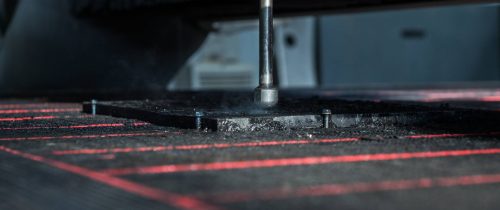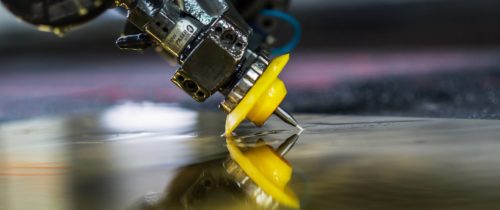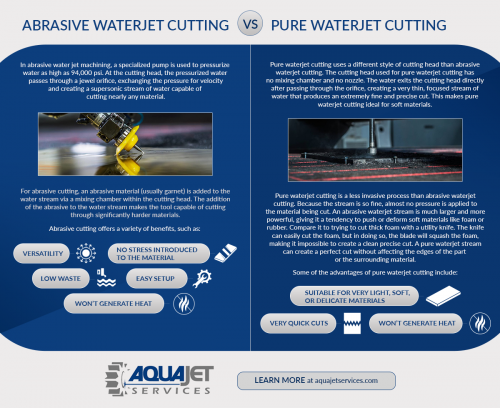Waterjet cutting is a cold cutting technique that produces clean and precise cuts on an expansive range of material types. Waterjet cutting originated with pure water cutting for paper and other very soft materials, but evolutions of the technology have placed various additives into the water stream to facilitate the cutting of harder materials.
Pure waterjet cutting simply uses a very focused, pressurized stream of water to make precise cuts. Abrasive water jet cutting adds an abrasive material such as garnet to the water stream, enabling it to cut through harder or thicker materials. In this blog post, we’ll discuss the differences between the two techniques to help you determine which is best for your project.
Pure Waterjet Cutting
Pure waterjet cutting uses a different style of cutting head than abrasive waterjet cutting. The cutting head used for pure waterjet cutting has no mixing chamber and no nozzle. The water exits the cutting head directly after passing through the orifice, creating a very thin, focused stream of water that produces an extremely fine and precise cut. This makes pure waterjet cutting ideal for soft materials.

Pure waterjet cutting is a less invasive process than abrasive waterjet cutting. Because the stream is so fine, almost no pressure is applied to the material being cut. An abrasive waterjet stream is much larger and more powerful, giving it a tendency to push or deform soft materials like foam or rubber. Compare it to trying to cut thick foam with a utility knife. The knife can easily cut the foam, but in doing so, the blade will squash the foam, making it impossible to create a clean precise cut. A pure waterjet stream can create a perfect cut without affecting the edges of the part or the surrounding material.
This makes pure waterjet cutting ideal for materials including:
- Felt
- Foam
- Food products
- Paper
- Rubber
- Thin plastics
Some of the advantages of pure waterjet cutting include:
- Suitable for very light, soft, or delicate materials
- Very quick cuts
- Won’t generate heat
Abrasive Waterjet Cutting
In abrasive water jet machining, a specialized pump is used to pressurize water as high as 94,000 psi. At the cutting head, the pressurized water passes through a jewel orifice, exchanging the pressure for velocity and creating a supersonic stream of water capable of cutting nearly any material.

For abrasive cutting, an abrasive material (usually garnet) is added to the water stream via a mixing chamber within the cutting head. The addition of the abrasive to the water stream makes the tool capable of cutting through significantly harder materials. It’s especially well-suited for thick or hard materials, including:
- Ceramic
- Metal (steel, aluminum, copper, etc.)
- Plastic
- Stone
Abrasive cutting offers a variety of benefits, such as:
- Versatility
- No stress introduced to the material
- Low waste
- Easy setup
- Won’t generate heat
Which Process is Right for You?
Choosing the right waterjet machining process is important to the success of the operation. The selection between pure waterjet cutting and abrasive waterjet cutting should be based on the material hardness, material thickness, and the required level of precision. Both waterjet techniques can cut through a variety of materials.
Cutting techniques that require heat may deform the workpiece or harden the edges, making secondary processes more difficult. Mechanical cutting methods often leave burrs on edges that need to be removed. Simply put, waterjet cutting offers cleaner, more precise cuts than most other traditional cutting methods.
At AquaJet Services, we specialize in abrasive and pure waterjet cutting and our equipment can cut through nearly any material. Contact us today for more information about our capabilities.


